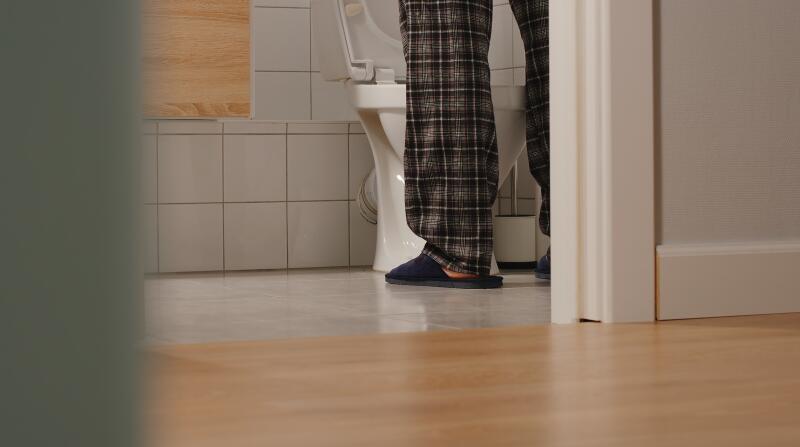Overactive Bladder: 10 Things Doctors Want You to Know

Medically Reviewed By William C. Lloyd III, MD, FACS
Written By Lorna Collier on August 26, 2021
-
 Expert Insight from OAB Doctors“OK, time to go. And I mean NOW.” If your overactive bladder could talk to you, that’s what it might say. And if you don’t heed its message quickly enough, prepare for a leak, or even a flood. Is there anything that can be done to control an overactive bladder (OAB for short), which affects at least 33 million Americans (both males and females)? Overactive bladder doctors we talked to answer YES. There is plenty that you can do to stem your unwanted tide
Expert Insight from OAB Doctors“OK, time to go. And I mean NOW.” If your overactive bladder could talk to you, that’s what it might say. And if you don’t heed its message quickly enough, prepare for a leak, or even a flood. Is there anything that can be done to control an overactive bladder (OAB for short), which affects at least 33 million Americans (both males and females)? Overactive bladder doctors we talked to answer YES. There is plenty that you can do to stem your unwanted tide -
 1. “Your friend’s bladder treatment might not work for you.”Incontinence—lack of bladder control—has several causes, with overactive bladder being just one, say doctors. “One person’s incontinence isn’t the same as another person’s,” says Dr. Suzette Sutherland, a urologist at the University of Washington in Seattle. “When people come in and say, ‘I want that [bladder] sling my neighbor has,’ I’m like, ‘Well, honey, that’s not going to help you.’ They have to understand what they have and what treatment is appropriate for them.” Overactive bladder treatment is not the same as treatment given for other conditions causing urinary leakage.
1. “Your friend’s bladder treatment might not work for you.”Incontinence—lack of bladder control—has several causes, with overactive bladder being just one, say doctors. “One person’s incontinence isn’t the same as another person’s,” says Dr. Suzette Sutherland, a urologist at the University of Washington in Seattle. “When people come in and say, ‘I want that [bladder] sling my neighbor has,’ I’m like, ‘Well, honey, that’s not going to help you.’ They have to understand what they have and what treatment is appropriate for them.” Overactive bladder treatment is not the same as treatment given for other conditions causing urinary leakage. -
-
 2. “Overactive bladder is different from stress incontinence.”Patients often confuse OAB and stress incontinence, says Dr. Nirit Rosenblum, urologist at NYU-Langone Medical Center in New York. “There are two types of leakage in women,” she says. “One is OAB leakage—I get a sudden urge to urinate and I can’t reach the bathroom in time and I leak.” The other is stress incontinence: “I leak predictably with certain activities—coughs, sneezes, exercise, various high impact activities.” OAB is a bladder dysfunction, Dr. Rosenblum explains, while stress incontinence is caused by weakened sphincter muscles. Some women have both, which is called “mixed incontinence,” says Dr. Sutherland.
2. “Overactive bladder is different from stress incontinence.”Patients often confuse OAB and stress incontinence, says Dr. Nirit Rosenblum, urologist at NYU-Langone Medical Center in New York. “There are two types of leakage in women,” she says. “One is OAB leakage—I get a sudden urge to urinate and I can’t reach the bathroom in time and I leak.” The other is stress incontinence: “I leak predictably with certain activities—coughs, sneezes, exercise, various high impact activities.” OAB is a bladder dysfunction, Dr. Rosenblum explains, while stress incontinence is caused by weakened sphincter muscles. Some women have both, which is called “mixed incontinence,” says Dr. Sutherland. -
 3. “Overactive bladder doesn’t always result in leaking.”Dr. Michael Kennelly, a urologist at Carolinas Medical Center in Charlotte, North Carolina, says some people with overactive bladder have “OAB dry,” which causes them to have frequent bathroom trips, but very little urine production. “OAB dry is when people feel like they’ve got to go all the time, but they don’t wet themselves,” he says, compared to “OAB wet,” which combines urgency with leaks. OAB dry occurs more often in males, and is often caused by an enlarged prostate gland, he says. Sometimes the prostate is so enlarged, men can’t urinate and “we put a catheter in,” says Dr. Sutherland.
3. “Overactive bladder doesn’t always result in leaking.”Dr. Michael Kennelly, a urologist at Carolinas Medical Center in Charlotte, North Carolina, says some people with overactive bladder have “OAB dry,” which causes them to have frequent bathroom trips, but very little urine production. “OAB dry is when people feel like they’ve got to go all the time, but they don’t wet themselves,” he says, compared to “OAB wet,” which combines urgency with leaks. OAB dry occurs more often in males, and is often caused by an enlarged prostate gland, he says. Sometimes the prostate is so enlarged, men can’t urinate and “we put a catheter in,” says Dr. Sutherland. -
 4. “Changing what you eat and drink can help relieve overactive bladder symptoms.”Sometimes, overactive bladder home remedies can help. Doctors often look first at lifestyle changes you can make, such as “quitting smoking, exercise, and weight loss,” says Dr. Kennelly. Avoiding bladder stimulants, such as caffeine and alcohol is another. “Coffee, tea, colas, citrus products, spicy foods, acidic foods—these can be triggers,” says Dr. Kennelly. Drinking too much of anything—even water—can be a problem, adds Dr. Rosenblum. Forget the adage to drink eight glasses of water daily: “There’s no scientific basis to that,” she says. Unless you’re on thirst-inducing medication, just drink when you feel thirsty, she advises.
4. “Changing what you eat and drink can help relieve overactive bladder symptoms.”Sometimes, overactive bladder home remedies can help. Doctors often look first at lifestyle changes you can make, such as “quitting smoking, exercise, and weight loss,” says Dr. Kennelly. Avoiding bladder stimulants, such as caffeine and alcohol is another. “Coffee, tea, colas, citrus products, spicy foods, acidic foods—these can be triggers,” says Dr. Kennelly. Drinking too much of anything—even water—can be a problem, adds Dr. Rosenblum. Forget the adage to drink eight glasses of water daily: “There’s no scientific basis to that,” she says. Unless you’re on thirst-inducing medication, just drink when you feel thirsty, she advises. -
 5. “We now have two classes of medicine to treat OAB.”For decades, doctors had only anticholinergic drugs available for OAB, such as oxybutynin (Ditropan). But, says Dr. Sutherland, these can cause “dry mouth, dry eyes, blurred vision, constipation, and a potential risk of dementia.” A new class of drugs—beta-3 agonists—avoids these effects, she says. Mirabegron (Myrbetriq), approved in 2012, may raise blood pressure in patients with hypertension. Vibegron (Gemtesa), approved in December 2020, doesn’t cause this, but it can be hard to get insurance approval (to cover the cost) because it’s so new, according to Dr. Sutherland. (For mild OAB, postmenopausal women also may be prescribed local vaginal estrogen therapies, Dr. Sutherland says.)
5. “We now have two classes of medicine to treat OAB.”For decades, doctors had only anticholinergic drugs available for OAB, such as oxybutynin (Ditropan). But, says Dr. Sutherland, these can cause “dry mouth, dry eyes, blurred vision, constipation, and a potential risk of dementia.” A new class of drugs—beta-3 agonists—avoids these effects, she says. Mirabegron (Myrbetriq), approved in 2012, may raise blood pressure in patients with hypertension. Vibegron (Gemtesa), approved in December 2020, doesn’t cause this, but it can be hard to get insurance approval (to cover the cost) because it’s so new, according to Dr. Sutherland. (For mild OAB, postmenopausal women also may be prescribed local vaginal estrogen therapies, Dr. Sutherland says.) -
-
 6. “Third-line therapies like Botox can help overactive bladder.”Besides lifestyle changes and medication, urologists may add “third line” treatments, says Dr. Kennelly, either alone or in combination with other therapies. Botulinum toxin (aka Botox) is one. Botox injections into the bladder “work to relax the bladder squeezing” and help treat OAB wet, he says. Overactive bladder botox therapy “is very effective for patients,” he says. However, it carries “a very low risk (about 5 to 6%) of urinary retention,” says Dr. Rosenblum, plus recurring urinary infections in about 15% of patients. New research is exploring other ways to get Botox into the bladder besides injection, says Dr Sutherland.
6. “Third-line therapies like Botox can help overactive bladder.”Besides lifestyle changes and medication, urologists may add “third line” treatments, says Dr. Kennelly, either alone or in combination with other therapies. Botulinum toxin (aka Botox) is one. Botox injections into the bladder “work to relax the bladder squeezing” and help treat OAB wet, he says. Overactive bladder botox therapy “is very effective for patients,” he says. However, it carries “a very low risk (about 5 to 6%) of urinary retention,” says Dr. Rosenblum, plus recurring urinary infections in about 15% of patients. New research is exploring other ways to get Botox into the bladder besides injection, says Dr Sutherland. -
 7. “Sticking a needle in your ankle can help improve your OAB symptoms.”Another third-line therapy is percutaneous tibial nerve stimulation. Dr. Sutherland says doctors “put an acupuncture needle down at the ankle and hook it up to a machine,” which stimulates nerves up your leg to your pelvic area “to try to reboot things” so the nerves will act properly. Patients typically undergo 30-minute weekly sessions for 12 weeks, then once monthly after that. However, researchers are studying implanted devices to allow more convenient and potentially more effective in-home treatment, says Dr. Sutherland, who is involved in a clinical trial for one such device.
7. “Sticking a needle in your ankle can help improve your OAB symptoms.”Another third-line therapy is percutaneous tibial nerve stimulation. Dr. Sutherland says doctors “put an acupuncture needle down at the ankle and hook it up to a machine,” which stimulates nerves up your leg to your pelvic area “to try to reboot things” so the nerves will act properly. Patients typically undergo 30-minute weekly sessions for 12 weeks, then once monthly after that. However, researchers are studying implanted devices to allow more convenient and potentially more effective in-home treatment, says Dr. Sutherland, who is involved in a clinical trial for one such device. -
 8. “We can implant a ‘pacemaker for your bladder’ to help regulate its signals.”Sacral nerve stimulation uses a small device, like a pacemaker, implanted near your sacrum (in your lower back, just above your tailbone), to provide 24/7 nerve stimulation to your pelvic region. With this therapy, “About 65 to 70% of patients will see improvements in symptoms to varying degrees,” says Dr. Kennelly. Most such devices contain a battery that must be replaced every 3 to 5 years, which means another surgical procedure. Newer devices have rechargeable batteries, meaning no reimplantation surgeries are needed, and are MRI compatible, says Dr. Rosenblum. Researchers also are working on smaller, less invasive stimulators, says Dr. Sutherland.
8. “We can implant a ‘pacemaker for your bladder’ to help regulate its signals.”Sacral nerve stimulation uses a small device, like a pacemaker, implanted near your sacrum (in your lower back, just above your tailbone), to provide 24/7 nerve stimulation to your pelvic region. With this therapy, “About 65 to 70% of patients will see improvements in symptoms to varying degrees,” says Dr. Kennelly. Most such devices contain a battery that must be replaced every 3 to 5 years, which means another surgical procedure. Newer devices have rechargeable batteries, meaning no reimplantation surgeries are needed, and are MRI compatible, says Dr. Rosenblum. Researchers also are working on smaller, less invasive stimulators, says Dr. Sutherland. -
 9. “You don’t have to live with OAB—it is not a natural part of aging.”“When it comes to overactive bladder, we can almost always make people better,” says Dr. Sutherland. “There is care available,” agrees Dr. Rosenblum, but unfortunately “there’s sort of a barrier to seeking care.” This can be caused by embarrassment (patients don’t want to talk to doctors about it), lack of knowledge of what’s available, or “just kind of accepting that this is part of aging. I think women in particular accept a lot of things, particularly after childbirth, as being ‘normal’ when it’s not normal. And it can be improved and treated.”
9. “You don’t have to live with OAB—it is not a natural part of aging.”“When it comes to overactive bladder, we can almost always make people better,” says Dr. Sutherland. “There is care available,” agrees Dr. Rosenblum, but unfortunately “there’s sort of a barrier to seeking care.” This can be caused by embarrassment (patients don’t want to talk to doctors about it), lack of knowledge of what’s available, or “just kind of accepting that this is part of aging. I think women in particular accept a lot of things, particularly after childbirth, as being ‘normal’ when it’s not normal. And it can be improved and treated.” -
 10. “You may need to see an OAB specialist to get advanced treatments.”While primary doctors can treat overactive bladder, to get third-line remedies and other expert help, you may need a referral to a urologist. “You could start with a general urologist and if you’re not getting the improvement you’re looking for, seek out someone more sub-specially trained,” says Dr. Rosenblum. Women may want to look for OAB doctors who have a subspecialty that combines urology and gynecology, formerly called urogynecology, now referred to as female pelvic medicine and reconstructive surgery (FTMRS). The important thing, says Dr. Kennelly, is to know that “there is hope out there.”
10. “You may need to see an OAB specialist to get advanced treatments.”While primary doctors can treat overactive bladder, to get third-line remedies and other expert help, you may need a referral to a urologist. “You could start with a general urologist and if you’re not getting the improvement you’re looking for, seek out someone more sub-specially trained,” says Dr. Rosenblum. Women may want to look for OAB doctors who have a subspecialty that combines urology and gynecology, formerly called urogynecology, now referred to as female pelvic medicine and reconstructive surgery (FTMRS). The important thing, says Dr. Kennelly, is to know that “there is hope out there.”
Overactive Bladder: 10 Things Doctors Want You to Know































